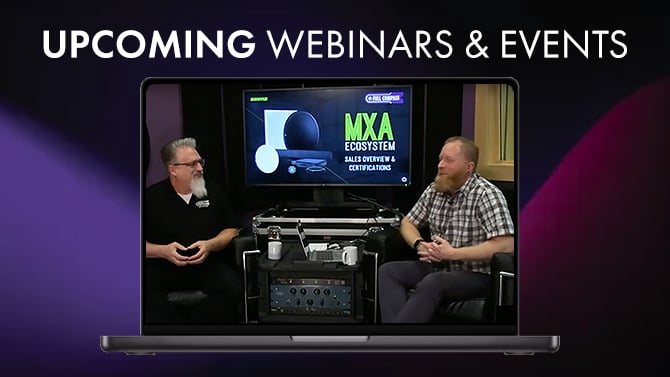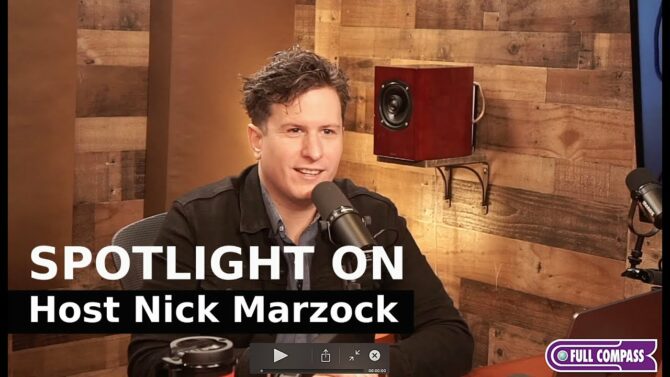Okay, I admit that was a click bait title. But since you’re here...hear me out.
A shootout implies that something will be left standing, but the reality is that there are no “bad” DAWs. They all have strengths and limitations, along with genius features—and long-standing bugs that were never fixed. They all have passionate devotees and equally passionate critics.
But here’s another slice of reality: they all fill specific needs. Some are better suited for some projects or types of music than others. Some go for speed, some depth Definition:
Definition:
The extent to which one parameter modulates another. Increasing depth increases the effect of modulation.. No one DAW Definition:
Definition:
(Digital Audio Workstation): A computer program or stand-alone device that provides digital audio recording, editing, and mixing. can have it all, but any DAW can have a feature another DAW doesn’t have. And they’re all made by different people with different philosophies about workflow—some of which may resonate with you, and some of which may not.
The following DAWs all have trial versions available...so why does this article even exist? Simple: Evaluating every single DAW is time-consuming, and any guidance as to which DAW might best suit your needs can help speed up the process of finding what’s right for you. Another issue is that because no one DAW does it all, it helps to be fluent in more than one program. In the spirit of full disclosure, over the years I’ve worked with every company whose DAW is covered here. But far from meaning I’m biased, it’s quite the opposite: I’ve learned how to use all of them, and in the process, found out what I think each DAW does best, and which applications are the best fit.
Also note that most companies make multiple versions of their programs. These can range from limited free versions to “light” versions that cost less, perhaps because they omit some of the more pro-specific advanced features, or include fewer bundled plug-ins. It’s worth perusing the comparison charts that manufacturers create to explain the differences among their products.
So, let’s look at the wide world of DAWs with some subjective evaluations. If something looks interesting to you, then by all means, check out the demo version, and see if you have chemistry with it. We’ll go through the DAWs alphabetically by manufacturer name. All are Mac/Windows-compatible Definition:
Definition:
Capable of operating with a particular selection of hardware or software., except as noted.
Ableton Live

I’ve often said most DAWs are a recording studio disguised as software—but Ableton Live is like a musical instrument disguised as software. It’s unique, and I know many people who are fluent in their DAW of choice and also use Live. I use it for live performance, because it’s rock solid. The only way I’ve found to make Live crash is to drop a laptop running it from 10 feet onto a concrete floor. Ableton also offers the hardware Push controller Definition:
Definition:
1. A MIDI device (keyboard, guitar with appropriate interface, etc.) that alters parameters in a synthesizer or other MIDI sound generator. 2. A device (e.g., modulation wheel, pitch bender, ribbon controller, etc.) that varies some specific parameter in a synthesizer or other MIDI sound generator., which makes Live into even more of a musical instrument.
Ableton came out of nowhere in 2001 as a program created by musicians to solve their own live performance needs, because nothing else sufficed for them. Live was a brilliant re-thinking of what recording and composition was all about. Its stark, 2D user interface Definition:
Definition:
A device that adds I/O capability to another device. Common would be a MIDI, audio or video interface for a computer. looked more like a microwave oven control panel than a tape recorder; it also put everything in one window—an interface design that would later be adopted by many companies. Most importantly, Live featured two totally independent views, Session View for songwriting and live performance, and an Arrangement view that resembled conventional DAWs and could record your Session View improvisations.
Over the years, Ableton has walked the fine line between adding features and maintaining its elegant simplicity—and in the process, acquired a user base that goes beyond its DJ/groove roots. The Session view is without equal for groove-oriented live performance. There’s a wide variety of stretching options to accommodate different types of audio, and the MIDI Definition:
Definition:
(Musical Instrument Digital Interface) A hardware/software standard for communication of musical data digitally among electronic instruments, effects, and computers. However it is also used for to control lighting, pyrotechnics, theatrical displays, and mechanical devices. For example, the fountains at the Bellagio in Las Vegas is controlled by MIDI. Also called MIDI 1.0. implementation—while basic (no notation or advanced editing)—is congruent with the program’s direct, effective philosophy. Although some DAW veterans can’t wrap their head around the Session View’s compositional paradigm, and some grouse about the lack of VST3 support (although there are workarounds), Live fulfills its intended function with elegance and efficiency. What’s more, it rewires into ReWire hosts (e.g., Pro Tools), as does the less expensive Ableton Intro version, when you want to add what Ableton does so well to a conventional DAW.
Acoustica Mixcraft Pro Studio

I think few would dispute that the Windows-only Mixcraft 8 Pro Studio earns the “biggest bang for the buck” title. Although the low price has remained constant over the years, the program has not. It now includes such as extras as Melodyne Essential, and if you’re into putting your music on YouTube, the video editing is superior even to industry leaders like Pro Tools (the people behind Mixcraft were involved with the Vegas video editing program, and it shows). Mixcraft supports MP4 Definition:
Definition:
A lossy digital compression coding container format for audio, video and text. as well as WMV and AVI Definition:
Definition:
(Audio Video Interleave): Microsoft's multimedia file container format. formats.
The price, feature set, and video functionality make Mixcraft viable as a DAW in its own right, but it also has a huge—and useful—on-demand sample library, with over 7,500 loops. I remember the days of needle-drop music for broadcast, and the cost of those libraries. Even if you don’t use Mixcraft as a DAW, the sample library, and ease of putting projects together due to the interface and the way it handles loops, make Mixcraft the least expensive needledrop music library you’ll find. I’ve put together several quick soundtracks with Mixcraft that would have taken much longer in any other DAW (with the possible exception of Acid Pro—assuming you already had enough sample libraries).
Mixcraft recently added a loop-triggering Performance Panel functionality that puts it more into Ableton Live’s turf of live performance; it also includes extras like a free remote Definition:
Definition:
A broadcast from the field, not from the studio. A Remote Control. app (Android/iOS) for mobile devices, MIDI scoring and staff view, and a step sequencer. Although earlier versions lacked some “pro” features, the latest version builds in sample-accurate delay Definition:
Definition:
A device that outputs and input signal some time later. This can be short for echo effects, longer for matching speaker stacks, or aligning sound and video. compensation, VST3 support, sidechaining, a unique “audio control” feature that allows audio signals to control instrument and effects parameters, and support for the latest Windows audio drivers as well as ASIO Definition:
Definition:
(Audio Stream Input/Output): A computer driver developed by German software company Steinberg to link hardware inputs and outputs with audio-based recording and playback programs. Used primarily with Windows operating systems.. Nested submixes and stem Definition:
Definition:
A submixed program often distributed for overdubbing, which can be a single track, combination of tracks, or several combinations of tracks. For examples, some mastering engineers combine stems of the rhythm section, vocals, and melodic instruments prior to mastering. exports are additional welcome features.
Mixcraft is a bit of a dark horse that flies under the radar (sorry about mixing metaphors), but over the past few revisions, it’s turned into a powerhouse that does most, if not all, of what most people need.
Avid Pro Tools

There’s an old saying that “no one was ever fired for specifying IBM,” and Pro Tools is the same way. It was an early entry in the world of digital Definition:
Definition:
A signal or data expressed as series of the digits 0 and 1, typically represented by values of a physical quantity such as voltage or magnetic polarization. recording—solid, and easy to understand. Whenever anyone told me they were transitioning from 2" 24-track Definition:
Definition:
A multitrack analog audio tape recording format using 2" tape. to hard disk Definition:
Definition:
A storage medium, typically applied to magnetic-based media (e.g., floppy disk, hard disk). recording, I always recommended Pro Tools. It’s not necessarily the most cutting-edge program, but it catches up eventually. It took seemingly forever for Pro Tools to adopt clip gain Definition:
Definition:
The amount of amplification provided by an amplifier circuit, expressed in dB or numerically as in "3X" = "3 times"., 64-bit operation, and elastic audio—but when it did, it was done right.
The detractors point to a tradition of being a closed ecosystem, including plug-ins that worked only in Pro Tools and nothing else. But ask other companies what the main cause of crashes are, and a lot of times, the answer will be third-party plug-ins. Pro Tools had control over its environment. And back when only a very limited number of computer systems were “qualified” by Digidesign/Avid for support, some people thought that was outrageous. I felt the opposite: the company was recognizing that different computer configurations were a minefield—but if you used what they qualified, they had your back.
Pro Tools continues to be the dominant DAW because you can count on it. It works, it’s known, it has an understandable workflow, and it’s well supported. Sure, Avid has done some things that have ticked off owners, like basically saying “you’ve gotten enough mileage out of your hardware, time for something new” or “your old plug-ins don’t work any more.” But those kind of changes are always in service of making sure that Pro Tools can retain its place in pro studios. Pro Tools is like a car that may not have the flash of a Lamborghini, but every time you turn the key...it starts. For professionals running a studio, Pro Tools’ predictability, ease of use, hardware integration, and ubiquity—when you need to do a file exchange with another studio, odds are you’ll be able to do it—are strong selling points.
Magix Acid Pro 8

When Sonic Foundry introduced Acid, it showed the world what could be done with looping Definition:
Definition:
1. (sampling) Repeating a section of a waveform so that it can sustain indefinitely. 2. (audio) The process of repeating a phrase or section of sound within a composition or recording. 3. (video) See: ADR. and audio. It had no MIDI, and limited recording to say the least, but the effortless way you could put loops together and create finished music was mind-blowing.
Then Sonic Foundry foundered, and was purchased by Sony. Acid stagnated, and with Sony’s emphasis on updating Vegas (a stellar video editing program), other contenders like Ableton Live, Fruity Loops, and even DAWs like Sonar left Acid in the dust. It went for years without an update, and barely serviceable MIDI. Acid became like one of those action movie heroes who gets beaten up mercilessly, and left for dead.
Then Magix bought Sony’s software, and rumors were that Acid was going to be resurrected. True to their word, we now have Acid Pro 8 (Windows only), which has become a 64-bit program. The latest version also includes new effects and instruments, 9 GB of loops, and improved MIDI capabilities. Like Reason and Live, it’s also a great candidate for rewiring into other hosts.
At present, Acid is a little thin as a “DAW” in the sense of being like Pro Tools, Cubase, Studio One, Digital Performer, etc. Future VST3 support is promised but hasn’t yet arrived (although there are workarounds, as there are for Live), and you won’t find MIDI Event lists, scoring, and other features expected in more comprehensive DAWs.
However, Acid remains a focused, fast way to convert loops into finished compositions. Furthermore, it’s clear that Magix is making a commitment to returning Acid to its former glory—and its rightful place an easy-to-use, loop-based composition program that extends into hard disk recording and MIDI. And Acid’s “secret weapon” endures: it’s fun.
MOTU Digital Performer

Digital Performer evolved from a MIDI-only sequencer into one of the original hard disk-based DAWs. As a result, its MIDI recording and editing is on a par with Cubase, and ahead of Pro Tools. It was a Mac-only program for years, and gained favor with those doing television and film scoring, in some cases due to its QuickScribe notation window—which can export via MusicXML to programs like Finale and Sibelius. What’s more, DP also does Windows (although I don’t feel it’s quite as polished yet as the Mac version).
As one of the first DAWs, DP followed its own path. While the interface makes sense to anyone who started with DP, those coming to it from other programs need to acclimate to a somewhat different paradigm; there’s a bit of a learning curve. However, over recent revisions DP has become friendlier, as well as adding to its feature set.
DP has a pro bent. For example, you can have multiple sequences in a single project, which is one reason why DP is popular for touring acts (the last time I saw Shania Twain, her stage act was run by twin DP-based systems). Its MIDI resolution Definition:
Definition:
1. (video) The measure of pixels horizontally and vertically. For example, 1920x1080 is considered HD, or high-definition. 2. (audio) The combined bit depth and sample rate of a digital audio signal. is essentially unlimited, because it stores the MIDI location with 64-bit precision; and DP supports video output through third-party video hardware. However, it also has sophisticated features for EDM Definition:
Definition:
EDM (Electronic Dance Music): A form of music, highly dependent on electronics and synthesis, and played mostly at clubs and dance parties. fans, like the Polar loop-based RAM Definition:
Definition:
(Random Access Memory) A method of solid-state data storage where stored data can be addressed in any order. RAM is volatile, meaning that all data is lost when power to the RAM is turned off. recorder and MX4 synth.
Perhaps surprisingly, for guitar/bass players DP has the most comprehensive amp sim Definition:
Definition:
A software program that emulates the sound of guitar amplifiers. toolbox of any DAW. The amps and effects are excellent, including the “amp rooms,” and there are also guitar-synth-like plug-ins. (Full disclosure: DP also modeled my Quadrafuzz multiband distortion Definition:
Definition:
A change in an electronic or acoustic signal's waveform. This can undesirable if it impacts signal quality, or desirable when used for creative signal processing. processor Definition:
Definition:
A device that modifies signals. In audio, this typically affect dynamics, frequency response, harmonics, or time. In video, processors typically affect color, intensity, and special effects., however, I don’t benefit financially from its inclusion.) These supplement an already rich roster of plug-ins.
DP always had a bit of a rarefied reputation, but its recent updates have added more mainstream capabilities, along with maintaining what established it as a major player in the first place.
PreSonus Studio One

Despite being over a decade old, many still think of Studio One as “the new kid on the block.” What sets it apart is fast, nimble operation. Instead of trying to be all things to all people, it focuses on its mission of being the fastest way to get from idea to master. When you work on a project in Studio One, it feels like someone sprayed WD-40 into your computer. If Pro Tools is a sedan, and Cubase an SUV, Studio One is a sports car (and unlike most sports cars, it doesn’t break Definition:
Definition:
An interruption in programming for commercials or station identification. down).
Studio One’s updates seem to alternate between mixing/tracking features, and compositional additions. Version 4 added Harmonic Editing, which can transpose even polyphonic Definition:
Definition:
The ability of an electronic musical instrument to play more than one note simultaneously. audio material according to a master chord track. I was shocked the first time it changed a guitar chord (this is not just about MIDI data Definition:
Definition:
Information used by a computer in order to arrive at a decision. Although this is a plural term, it's often treated in the singular.) to a totally different one. Although designed more for prototyping songs because of the inherent issues involved in pitch Definition:
Definition:
For a given range of audio frequencies, pitch represents where a single sound falls within that range. transposition, when combined with their Arranger track and Scratch Pads that allow experimenting with edits that don’t alter the main composition, songwriting with Studio One is highly evolved and refreshing. And while their newly updated Impact XT percussion/loop trigger Definition:
Definition:
A signal that starts an event. and Sample One instruments may seem redundant if you have a bunch of virtual instruments, their integration with the program itself is unique.
There are omissions for MIDI—there’s no event view or staff view (although PreSonus’s Notion scoring software integrates with Studio One), and the selection of MIDI effects is sparse. However, Studio One has a feature no other DAW has—a separate mastering Definition:
Definition:
Compiling individual recordings into an album or collection of songs, or an individual song for a single release, often with added equalization, dynamics processing, and other signal processing to create a consistent and optimized listening experience. With albums, mastering can also involve determining the sequence of the individual recordings. page that integrates with the main DAW’s song page. For example, suppose you’re mastering an album and realize that on one song, the vocal needs to come up a bit to match the others. You can click over to the song, make the change, then “compile” the mix back to the mastering page with another click. When doing album assembly, nothing beats Studio One’s integrated teaming of songs, mastering, and album assembly for ease and efficiency.
Propellerhead Software Reason

Reason started as a groundbreaking, MIDI-based virtual studio (no audio). When first demonstrated at Winter NAMM Definition:
Definition:
NAMM (National Association of Music Merchants): A professional, not-for-profit trade organization that promotes the benefits of music-making. NAMM also refers to the twice-yearly trade shows the revolve around music dealers, manufacturers, and educators., I was concerned all the jaws dropping and hitting the floor might trigger an earthquake. Since then, Reason has added audio recording, and even abandoned its reluctance to host VST Definition:
Definition:
(Virtual Studio Technology) Steinberg's specification for plug-in software, compatible with DAWs that run on Windows or MacOS, if supported by the host program. plug-ins. While it remains at heart a highly sophisticated MIDI studio that’s ideal for EDM, it’s also now used by many musicians for conventional recording.
Reason is also very stable (I used it for my EDM solo act before Live came to market). It feels like a studio, and follows a rack Definition:
Definition:
A frame for holding gear that meets an industry standard for enclosures. This specifies a 19 inch width, and a height that is some multiple of 1.75 inches. A rack frame can be open or enclosed, and has rails drilled with standardized screw holes for attaching rack equipment. paradigm religiously—you can “flip the rack around,” and gain access to patch points that blur the line between a studio and one heck of a modular synthesizer.
Although it has limitations as a general-purpose DAW, these are deliberate in order to maintain the focused workflow and ease of use. However, if someone wants to expand their DAW setup and has a MIDI orientation, I recommend Reason because it comes with a number of truly excellent virtual instruments and effects (as well as intuitive, fast MIDI sequencing) and can ReWire into any host. Reason was the first DAW to take virtual instruments to their limits, and they’ve only gotten better over the years.
For those who want to take advantage mainly of the virtual instruments, Reason Intro is a steal. For under $100, you get 9 instruments (synthesizers, samplers, drum machines), 12 effects, and exceptional MIDI sequencing—standard, pattern-based, and the ReGroove groove console. Whenever people would complain about a paltry selection of plug-ins in their DAW, I always would tell them to ReWire Reason in as their “backline” instrument and effects rack.
Reason fans might think my description minimizes Reason’s power, but don’t get me wrong—you can do serious music with Reason. It’s just that I’ve never met a program that’s so well-suited to ReWiring into a host, and in the process, giving you a huge increase in functionality.
Steinberg Cubase

As one of the early MIDI sequencers, Steinberg continually pushed the envelope. They invented Virtual Studio Technology (VST) that put instruments, effects, and an entire studio inside the computer. Steinberg was the first company to see the handwriting on the wall: In the future, everything would live within the computer, and software would dominate over hardware.
Steinberg also introduced the ASIO protocol for low-latency Definition:
Definition:
The amount of delay a signal, data, sound, video, or control signal acquires within a device, system, or long-distance connection. audio streaming Definition:
Definition:
A method of sending a continuous flow of digital content over IP (Internet Protocol) networks, and often, tailors itself to the user's receiving capability. with hard disk recording. Like VST, this standard was embraced immediately by an industry that had been ignored by Apple and patronized by the PC. Although Apple moved along to Core Audio, ASIO continues to rule for Windows. (Steinberg also introduced Nuendo, a more expensive program oriented toward post-production.)
Cubase is a well-rounded, deep program that pretty much does everything well—superb notation, various time-stretching options, MIDI, audio recording, integrated hardware controllers (the CMC line), you name it. And as the inventor of VST, virtual instrument Definition:
Definition:
A software-based simulation of a musical instrument, controllable by a computer interface or physical controller. support is primo; the MIDI editing is outstanding, as is their innovative MIDI Note Expression feature. Many consider Cubase the most capable program for working with MIDI. There are plug-ins a-plenty, including a comprehensive set of MIDI plug-ins (why more companies don’t recognize their value always surprises me), and the included instruments are perhaps not spectacular, but they’re hands-down useful. The bottom line is if something can’t be done in Cubase, it probably can’t be done.
The main limitation is a somewhat unwieldy feel compared to newer programs. It’s been around for so long that it has to maintain what it did, even while adding new features. On the upside, some of the complication involves setup, and once everything is set up as desired, you can get working very quickly. Also, you’re not obligated to learn everything! For some people, Cubase might be overkill—but for others, it will be everything they ever wanted, and then some—and the odds of anyone outgrowing it are remote, to say the least.
Coda
And there you have it: eight DAWs compared. As you can see, they all have some exceptional attributes, and they’re all quite different from each other. Fortunately, the trial versions and free, time-limited downloads make it much easier for you to decide which program works best for you. As mentioned at the beginning, I’ve used, and continue to use, all of them. While all of these programs have limitations, all of them are also have major strengths.
And if you’re using one DAW, consider learning another. Once you get past the surface differences, you can become proficient in a relatively short time. With my primary instrument being guitar, I couldn’t imagine having only an acoustic or only an electric guitar—similarly, I can’t imagine using only one DAW. When I start a project, I pick the one that’s going to do the job most efficiently.
If only one of these programs existed—any one of them—I’d still be able to make music, and have a great time doing so. But the fact that we have this kind of choice is almost an embarrassment of riches. No matter which one ends up being most compatible with your way of making music, you’ll have a great time.










